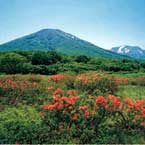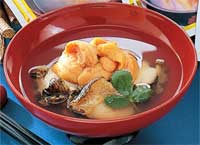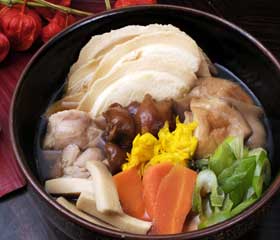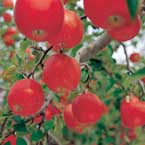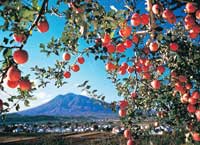Web Japan > Trends in Japan > Food & Travel > Aomori Offers Culinary Treats For All Seasons
Aomori Offers Culinary Treats For All Seasons
Northern Land Boasts Bounty from the Ocean and Mountains
Located at the northern tip of Japan's main island of Honshu, Aomori Prefecture, which has a population of 1.44 million, is a fertile land rich in natural beauty and encompassing verdant forests and the Hakkoda mountain range. The region is known for Shirakami-Sanchi, a mountainous, unspoiled expanse of virgin forest containing some of the world's largest tracts of beech trees that has been designated as a UNESCO World Heritage Site, as well as the Aomori Nebuta Festival, a fire festival that is famous throughout Japan. With shores touching the Sea of Japan, the Pacific Ocean, and the Tsugaru Strait, in addition to an inland sea bordered by two peninsulas, the prefecture boasts a wealth of marine resources. Thanks to its climate of four distinct seasons, fruits and vegetables from the region are also delicious. The farming, fishing, and mountain communities of Aomori are a treasure trove of traditional recipes and cooking methods using local ingredients.
Traditional Seafood Fare
One of the local specialties of Aomori is a seafood dish called ichigo-ni (literally "stewed strawberries"). The dish is said to have originated among fishermen in the Hachinohe area, who would simmer fresh uni (sea urchin) and awabi (bearded clam) in sea water, having located the ingredients using "box glasses" (a box-shaped device for seeing underwater made of wood and glass) and retrieved them by skin-diving. In the dish now common in Aomori, uni and awabi are lightly simmered in a kelp-based soup stock to which only salt and light soy sauce are added for seasoning. Shreds of aojiso (green shiso/perilla leaves) provide the finishing touch.
Made from these two marine delicacies and eaten with just the seasoning of salt and the aroma of shiso, the dish is simple yet luxurious. Not only does it look wonderfully appetizing, but the flavor combination is exquisite. The dish was given the name ichigo-ni because the pieces of uni floating in the white, milky broth look like wild strawberries in the morning mist. It is often served as a soup dish on special occasions.
Home-Style Stew with Crackers
A well-known dish in the southern part of Aomori is senbei jiru (cracker broth) in which locally produced crackers called nanbu senbei are broken into pieces and added to a stew containing such ingredients as chicken, pork and fish chunks, as well as various vegetables and mushrooms. Nanbu senbei are made from a flour and salt mixture that is baked in round molds. Among the different varieties of nanbu senbei, only two—otsuyu senbei and kayaki senbei— are used for senbei jiru since they are baked to produce a unique texture that does not melt or break down even when boiled. The dish is ready to eat when the crackers have absorbed some of the broth but still remain crunchy. Diners can enjoy both the unique taste produced from the combination of juices soaked up by the senbei and the crunchy texture.
The Apple Capital of Japan
The first thing that springs to mind for many Japanese when they think of Aomori is the region's apples, which are widely acclaimed for their quality and flavor. The prefecture takes great pride in being the producer of around half of all of Japan's apples. There are a number of varieties, including Fuji, JonaGold, Tsugaru, Ourin, Mutsu, and Kogyoku, all of which are distinct in terms of acidity, sweetness, juiciness, aroma, size, coloring, and firmness.
Of course they taste best when eaten straight off the tree, but you can also take advantage of the unique characteristics of each one by preparing them in different ways. For example, the Kogyoku variety is good for making such treats as apple pie or baked apples, because the flesh does not break apart or become mushy when cooked. Fuji apples are best for salads, sauces, or desserts since they are sweet and have crisp, nicely colored flesh. Mutsu apples have just the right amount of acidity and firmness to go well with meat dishes and make a great jam.
From seafood to crackers to apples, Aomori is an area where visitors can experience simple yet delicious foods throughout the year. (February 28, 2008)


